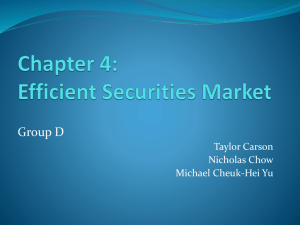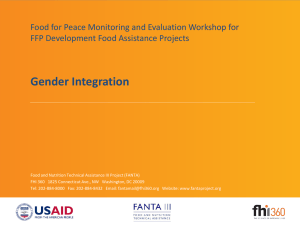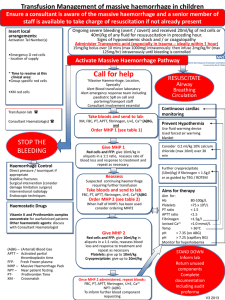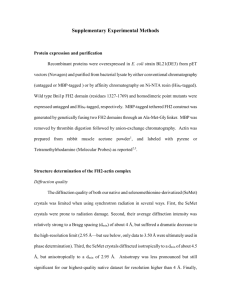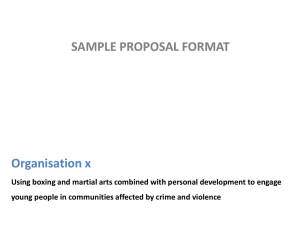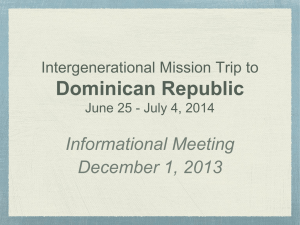Frequent Flier Programs - not a zero-sum game after all
advertisement
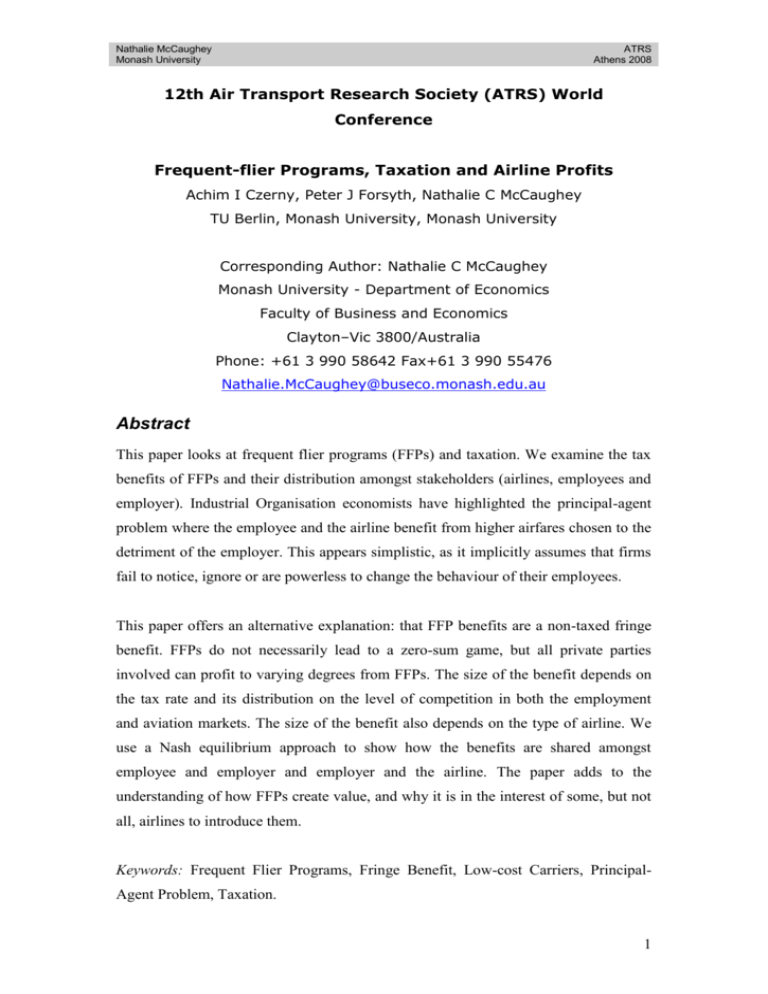
Nathalie McCaughey
Monash University
ATRS
Athens 2008
12th Air Transport Research Society (ATRS) World
Conference
Frequent-flier Programs, Taxation and Airline Profits
Achim I Czerny, Peter J Forsyth, Nathalie C McCaughey
TU Berlin, Monash University, Monash University
Corresponding Author: Nathalie C McCaughey
Monash University - Department of Economics
Faculty of Business and Economics
Clayton–Vic 3800/Australia
Phone: +61 3 990 58642 Fax+61 3 990 55476
Nathalie.McCaughey@buseco.monash.edu.au
Abstract
This paper looks at frequent flier programs (FFPs) and taxation. We examine the tax
benefits of FFPs and their distribution amongst stakeholders (airlines, employees and
employer). Industrial Organisation economists have highlighted the principal-agent
problem where the employee and the airline benefit from higher airfares chosen to the
detriment of the employer. This appears simplistic, as it implicitly assumes that firms
fail to notice, ignore or are powerless to change the behaviour of their employees.
This paper offers an alternative explanation: that FFP benefits are a non-taxed fringe
benefit. FFPs do not necessarily lead to a zero-sum game, but all private parties
involved can profit to varying degrees from FFPs. The size of the benefit depends on
the tax rate and its distribution on the level of competition in both the employment
and aviation markets. The size of the benefit also depends on the type of airline. We
use a Nash equilibrium approach to show how the benefits are shared amongst
employee and employer and employer and the airline. The paper adds to the
understanding of how FFPs create value, and why it is in the interest of some, but not
all, airlines to introduce them.
Keywords: Frequent Flier Programs, Fringe Benefit, Low-cost Carriers, PrincipalAgent Problem, Taxation.
1
Nathalie McCaughey
Monash University
ATRS
Athens 2008
‘The avoidance of taxes is the only intellectual pursuit that still
carries any reward.’
John Maynard Keynes
(1883 – 1946)
1. Introduction
In 1981 American Airlines (AA) launched the first digitally based frequent flier
program (FFP) in a format that has since become industry standard. The airline was
from the beginning very candid whom its rewards program, AAdvantage, was
intended to target: it’s ‘most frequent customers’. AA’s initial database counted
150.000 of the most frequent users of its services. The vast majority of these users
subsequently emerged as being heavily reliant on airline services for business
purposes. That FFP’s would indeed quickly become very attractive to these regular
business travellers has however more to do with serendipity than with shrewd
strategic planning by AA or its early emulators, such as United Airlines.
AA launched AAdvantage just 2 years after deregulation of the American domestic
aviation market. The publically stated reason being, that differences in service quality
was not enough to inhibit the reigning fierce competition from driving airlines into
bankruptcy, hence the creation of a competitive edge in the form of AAdvantage.
Further in AA’s favour was that although airfares dramatically decreased in the wake
of deregulation, the wider public had not yet learned to perceive an airline trip to be
similar to a bus trip. Using a plane regularly, the only requirement1 to become a
member of the AAdvantage program for example, was initially confined to a minority
of ‘lucky one’s’ who had to fly on business. By 1991 all major American carriers had
introduced an FFP overall counting approx. 40 million members, of which 72% were
classified business passengers. Within twenty-five years FFPs had developed into a
standard feature of airlines services. Today all major full-service carrier and a large
number of low-cost
carriers
specifically targeting business
travellers (ie
Germanwings) offer some form of loyalty program. Although the programs did
evolve over time one thing has remained unchanged, FFPs are still most attractive to
business travellers who do not pay their own way. Indeed at present 94% of business
1
Initially AAdvantage members were awarded membership based on the distance travelled not on the
fare they paid.
2
Nathalie McCaughey
Monash University
ATRS
Athens 2008
travellers belong to at least one FFP2. It is this attractiveness to business travellers that
has raised much interest amongst economist. Popular opinion (ie The Economist) and
most of the sparse economic literature on loyalty programs either implicitly (ie the
switching cost literature championed by vonWeizaecker and Klemperer) or explicitly
(ie Basso and Ross) premise their work on the principal-agent assumption whereby
the employee and the airline benefit from higher airfares chosen to the detriment of
the employer. This populist view of FFPs suggests that FFPs enable airlines to exploit
the existing agency relationship between the person booking the air travel and
collecting the FFP benefits, given FFP membership is bound to an individual and not
to a legal person, such as a firm, but this person is not the one paying the fare.
According to Ross and Basso (2006), FFPs ‘are a bribe to business travellers,
tempting them to select higher priced airfares and possibly even take unnecessary (or
less convenient) flights, paid for by their employer, in exchange for a small personal
benefit in the form of program miles or points’. In other words FFPs lead to a zerosum game.
This often cited potential for abuse, although intuitively appealing, is however a rather
simplistic view. It implicitly assumes that firms either fail to notice, choose to ignore
or are powerless to change the behaviour of their employees. We therefore propose an
alternative explanation to the current paradigm. In our view the often, but not always
(see Banerjee and Summers 1987), overlooked non-taxed fringe benefit aspect of
FFPs rewards is a reason for why these programs do not necessarily lead to a zerosum game. In fact all private parties involved can profit to varying degrees from FFPs.
The size of the benefit will depend both on the tax rate and the type of airline (ie full
service carrier or low-cost alternative). The distribution of the benefit will rest on the
level of competition in both the employment and aviation markets.
Our purpose is to show that the FFPs need not to built on a principal-agent dilemma to
be successful, but that the non-taxed fringe benefit characteristic of FFP rewards is
what drives them. We aim at increasing the understanding of the role of FFPs in
oligopoly markets, how FFPs create value for airlines and consumers, and why it is in
the interest of some, but not all, airlines to introduce these programs. We use a Nash
2
Uncles and Goh (2002).
3
Nathalie McCaughey
Monash University
ATRS
Athens 2008
equilibrium model approach to show that firstly FFP’s make it possible for private
agents to reap rents, secondly that these rents undergo a three way split between
employee, employer and airline and finally that only those airlines targeting business
travellers are in a position to provide FFPs giving rise to these rents.
The present paper proceeds as follows: first the three possible taxation transactions
points will be highlighted and those tax approaches that have been applied in a
number of developed nations. Then the paper proceeds to concentrate on the fringebenefit tax and outlines which type of traveller is most likely to benefit from the taxfree nature of the FFP award. Section 4 outlines the theoretical model on which we
base our analysis of the distribution of gains between employee (traveller), employer
and a full service carrier. Section 5 extends the basic model to include the
introduction of an FFP by a low-cost carrier and shows why introducing an FFP might
make little economic sense for such a carrier. A succinct conclusion provides
directions for further research and finalizes this paper.
2. What and how to tax
Depending on their program design airlines call the FFP product either “miles” or
“points”. In order to avoid confusion this paper will strictly uses the term “points”.
The owner of the FFP, which will most likely be an airline, but could be any
company3, produces FF-points. These points come into being by either entering into a
legal contract with a consumer directly4 or alternatively a program partner, such as a
bank or credit card company. If one agrees that the points produced by an FFP are a
‘good’, then taxing either the production or the consumption of this good is not a
hypothetical undertaking. Figure 1 depicts the three possible transaction points where
taxation can be applied in the FF-points production/consumption chain.
3
Loyalty companies, such as Aeroplan in Canada and an equivalent company in Mexico, were created
through the sale of the FFP-business unit by the airline, Air Canada and Mexicana respectively.
Aeroplan was sold in 2005 and listed on the stock exchange. Mexicana’s FFP has been sold in January
2008 and will be trading as an independent company in the near future.
4
Indeed becoming a member in a FFP is entering into a contract with the company providing the FFP
service.
4
Nathalie McCaughey
Monash University
ATRS
Athens 2008
Taxation
Purchase Tax
FFP
‘Owner’
Program
Partner
Fringe Benefit Tax
Program
Member
‘Loyalty’
Reward
Hypothetical Tax Case
Figure 1
Hypothetical Tax Case
The most unlikely but nevertheless theoretically possible case to which taxation could
be applied to is when the points are credited by the points issuer to the program
member. This case is depicted in green in Figure 1. This is a hypothetical because the
points alone carry no economic value in the eyes of the member. The points are
merely numbers on a transaction record that, unlike currency, expire within a given
time frame contingent on the rules governing the FFP. Theoretically the accumulated
points become instantaneously valuable once a given threshold, again governed by the
rules of the FFP, has been reached. Once the threshold is achieved, the points value
comprises two components, the intangible options value, that is the customer’s choice
between redeeming or not, and the tangible value of the underlying reward. However
even when the threshold is reached the points can still expire before redemption takes
place5. This realistically means that for members points become only valuable at the
time of redemption. Taking this into consideration it is nonsensical to tax the
awarding of points given that at this point no tax base exists. To the authors best
knowledge no jurisdiction has ever considered taxing the award of points.
The two realistic taxation scenarios, which have been implemented in a number of
countries, are the application of either a purchase tax or alternatively a fringe-benefit
tax. Although, for reasons of completeness, both possibilities are elaborated on in this
section, the economic model is built on the general sales tax.
5
In fact about two-thirds of points accumulated are never redeemed. This is however because the
points often expire before the necessary redemption threshold has been reached.
5
Nathalie McCaughey
Monash University
ATRS
Athens 2008
Purchase Tax
A general sales tax or value added tax, such the goods and services tax (GST) in
Australia, can be levied at the point of sales of the points by the airline or other points
issuer to any of its legal program partners, such as credit card companies, rental car
companies etc. This situation is depicted in figure 1 in blue.
The reason this tax takes on the form of a general sales tax is because once the points
issuer enters into a sales contract with the points buyer an explicit price per point has
negotiated between the two parties. This price strongly depends on the negotiation
power of each part, but as a general rule will lie anywhere between 0.5 and 2 US cents
per point. The price per point has to be paid before the points are made available to
end-consumers and hence the sales revenue will accrue to the points issuer even if the
end-consumer never redeems the awarded points. Unlike the hypothetical case, the
points have a tangible economic value as soon as a price has been agreed upon and a
legally binding contract has been entered. The economic value of these points can also
be observed in the usual practice of credit card companies e.g. to re-coup their outlay
in form of higher consumer fees on credit cards awarding points. Having a price per
mile in turn allows for a tangible tax base on which to apply a value added tax.
Up until 2002 Italy levied such a VAT on the sales of points to program partner but
following the United Kingdoms lead has dropped it since. The sales tax on points was
abolished in the UK in 1997, a move which was welcomed by UK registered airlines,
because program partners became increasingly important in airline revenue generation
and, unlike Australia, program partners could not claim this tax outlay back. The tax
change was made possible defining points as fare prepayments, which are exempt
from VAT.
The United States introduced in 1997 a Federal Excise Tax of 7.5%, which has since
become known as the ‘Frequent Flier Tax’. This tax is applied to the sales of points
by US points issuers to American and international program partners and is paid by
the program partner. The resulting incremental cost is generally absorbed by the
program as part of their marketing costs and hence only passed on indirectly to the
end-consumer through e.g higher fees. US car rental companies however seperatly list
this tax on the invoice only charging it to clients identified through their FFP
6
Nathalie McCaughey
Monash University
ATRS
Athens 2008
membership number as points collectors. Given the observable strong trend of points
collection through program partners and not airlines, the VAT makes economic sense
and has been applied in a similar fashion in other countries such as Australia.
In Australia program partners are charged a goods and services tax for all the points
sold to them by points issuers. The amount of this tax is however reduced by the
proportion of points expected to be redeemed outside Australia6 and most program
partners (except banks) can claim this tax back.
In general a general sales tax does not penalise airlines registered in nations applying
this tax, because this tax is levied on the program partners. One could envisage a
possible disadvantage if program partners decided to shift their business from national
airlines to airlines registered in countries without such a tax. This has however thus
far not been observed and appears highly unlikely due to a number of barriers, e.g. the
National Australia Bank would send a bizarre possibly damaging message to its
Australian customers if it began awarding Emirate Airlines points. Although a VAT
has found only limited application worldwide, its use remains still more frequent than
the application of a fringe-benefit tax on the FFP awards. The next section highlights
how such a tax works, which countries have introduced it or alternatively failed at
introducing it and the possible reasons for failure.
Fringe-Benefit Tax
A fringe benefit is a benefit provided in respect of employment. This effectively
means a benefit provided to somebody because they are an employee. Fringe benefit
tax thus applies only where a benefit has been earned within an employment situation
that is not already taxed through the payroll tax. The rationale being that this tax
restores equity to those employees who do not receive such benefits. Hence where an
employee earns points within the scope of his employment duties and uses these
points to redeem for private purposes, be it a private free flight for him/herself or
family members or alternatively any other good that will not be used for work, the
employee has benefited from a fringe benefit, just as he/she would have from a
6
For example with 10% GST, if 20% of points are redeemed on international flights, the points issuer
charges 10% GST on 80% of points, which translates into 8% on all points sold.
7
Nathalie McCaughey
Monash University
ATRS
Athens 2008
company car. Under these circumstances it appears logical that a fringe benefit tax
should be levied on the award. Levine (1987) for example advocates requiring
travellers receiving benefits on fares for which they did not pay to self-report theses
points as taxable benefits of employment. However problems arise with this approach
in that collecting points is not akin to redeeming these (see the hypothetical case).
Figure 1 hence depicts in red fringe-benefit tax transaction point. It is thereby
inconsequential whether the points were awarded directly through the airline or
alternatively through a program partner such as a credit card company as long as the
credit card was used for work purposes and paid for by an employer. The tax base is
in this case the value of the good or service that the points are redeemed against. In
cases where a good, such as an Ipod, has been awarded determining the tax revenue is
unproblematic as price lists for Ipods are freely available. Tax authorities have
however encountered large problems with the determination of the prices of award
flights, given that airlines do not make any comparable ‘award fares’ available. The
value of the fare to the travellers hence varies according to the redemption
restrictions, the chosen destination and the prevailing fare structure.
Initially jurisdictions, such as the UK, aiming at taxing these benefits took a lead from
the taxation of travel benefits available to airline staff in the UK (Humphreys, 1991).
These benefits were valued for taxation purposes on a marginal cost basis, ie in terms
of the additional cost to the airline of providing the benefit. Many economists (ie
Summers and Banerjee, Klemperer etc) have since used this approach to argue that
introducing FFPs to increase switching costs is an almost costless undertaking for
airlines. From a taxation point of view arguing that only the marginal cost associated
with providing a service to an additional passenger is so low, that tax authorities did
not regard it worthwhile to collect the tax owed. The marginal cost approach however
was legally challenged in 1991 by the British Inland Revenue Agency. Following this
challenge, the UK courts decided that concessionary travel should be treated as a
taxable benefit in kind and valued on an average cost basis. This court ruling greatly
increased the perceived value of the benefits and ensured that airline staff travel
concessions were taxed as income. However this ruling was not further extended to
include the awards from FFP as these are not earned from an employment situation as
such, but are a based on a consumer relationship between the airline and the traveller.
8
Nathalie McCaughey
Monash University
ATRS
Athens 2008
Consequently, although fringe benefit tax exists in the UK, awards earned through
FFPs remain tax-exempt.
In those nations, which do apply a fringe benefit tax, the current consensus is to base
the fringe benefit tax on the cheapest fare available at the time of redemption on the
route against which the points are redeemed against.
Interestingly the only country to currently apply a tax on the consumption of the FFP
award is Italy. However this is not the result of defining the FFP award as a fringe
benefit but curiously of a law passed in the 1980’s forcing lottery operators to payout
20% of the value of the disbursed winnings to the state. When Alitalia introduced its
FFP, the Italian government defined the FFP awards simply as winnings. The tax base
was set to the average ticket price net of travel agency commissions and other
applicable taxes. Interestingly and similar to the current German situation, this tax is
being paid by the FFP operator and can not be passed onto the FFP members. In
theory all FFP operators should pay this tax to the Italian government, but this is
currently not being enforced, which as a consequence puts Italian airlines operating an
FFP at a competitive disadvantage7. A large number of other countries have tried to
introduce a fringe benefit tax on FFPs all for various reasons with limited success.
The Netherlands regard FFP awards as fringe benefits and hence employees
redeeming points are liable under the fringe benefit tax scheme. The tax is in practise
however not being applied. KLM-Air France though safeguards itself against possible
claims by way of disclaimer, making its FlyingBlue members aware that according to
Dutch law, they are liable to undertake the necessary tax payments. Switzerland was
initially in a similar situation as the Netherlands, whereby the current tax laws regard
fringe benefits as taxable and FFP awards fall under the definition of fringe benefits.
However largely due to the problems associated with the valuation of flight awards
FFP awards were subsequently exempt from fringe benefit tax, which is a similar
situations in Sweden.
In 1996 the German government defined the FFP awards as fringe benefits, hence
making them taxable under German income tax. The German fiscal authorities
however allowed the awards to be exempt from taxation as long as the total value of
7
In 2002 Alitalia had to pay over 6 million Euros in tax due to this regulation.
9
Nathalie McCaughey
Monash University
ATRS
Athens 2008
the award per fiscal year does not exceed 2400 German Marks (~1200 Euro).
Reacting to this, the German flag carrier Lufthansa AG entered into an agreement
with the fiscal authorities. This agreement stipulates that Lufthansa AG pays a flat
rate tax on any reward values above the threshold value in lieu of its customers. This
means that those customers, whom Lufthansa regard as its ‘big spenders’ would
remain exempt from any form of fringe benefit tax. Eleven years on, this agreement is
still in force although a path-breaking decision of the German labour court
'Bundesarbeitsgericht' (9 AZR 500/05) has recently defined that points earned in the
course of business travel belong to the employer not the employee. Consequently the
tax liability was shifted from the employee to employer, which has however thus far
not had any impact on the status quo. Lufthansa AG still pays the flat tax, which
shows that Lufthansa AG is well aware that any form of consumer tax would simply
decreases the value of its program.
In Australia, FFP awards are also regarded as fringe benefits, however in practice no
enforcement of the 46.5%8 fringe benefit tax has taken place. A country specific
possible reason for this could be that Australian tax law allows minor benefits of a
value lower than $300 AUD and benefits that are incurred infrequently and irregularly
to be exempt from the fringe benefit tax. Australian tax authorities seem to regard
FFP awards that are of a higher value than $300 AUD as being such an infrequent
occurrence that the costs associated with pursuing a taxation of these awards would
almost certainly outweigh the revenue from the resulting taxation. Interestingly the
Commonwealth government of Australia prevents its public servants from redeeming
any points earned on official travel. They can join a frequent flyer scheme for official
purposes but are not allowed to is government policy receive personal benefit from
points accrued while travelling on official business. They are allowed to privately
participate join an FFP however, they have to distinguish between private and workrelated travel and ensure that there is no link between the two that may result in a
personal gain from work-related travel as they otherwise face severe penalties.
In the United States the most recent Internal Revenue Service (IRS) ruling states that
award tickets are taxable if they were earned in the course of business travel and
8
This represents the highest marginal income tax rate (45%) plus the Medicare Levy (1.5%) in
Australia.
10
Nathalie McCaughey
Monash University
ATRS
Athens 2008
subsequently used for leisure travel. This regulation is based on section 61 of the
Internal Revenue Code which states that gross income includes "all income from
whatever source derived’ and on section 1.61-21(a)(1) of the Treasury Regulations
which provides that gross income includes the value of fringe benefits such as
employer-provided free or discounted air travel. However taxation has, as in all other
nations which tried to apply a fringe benefit tax, been very difficult for a number of
reasons. Firstly the appropriate tax base is a major issue and secondly the currently
used accounting systems in firms do not perfectly report the true employee
compensation being paid to workers, nor for the separate costs of the business trip and
the frequent flyer bonus. Furthermore the lack of tax authority guidance over when
the points are income (i.e., when earned, when redeemed for a ticket, or when the
ticket is used) and how to value the miles (i.e., resale value, a uniform amount per
mile earned, or an amount determined by the value of the ticket received) makes it
impossible to accurately report this income source. Although software programs and
websites designed to facilitate corporate tracking of employees' frequent flyer miles
are in existence, these do not overcome the difficulties associated with the timing of
the income inclusion and the value of the award. Hence adhering to tax laws is
extremely difficult for employers and reporting this income source has been almost
non-existent. The IRS has not taken any action to follow up on this. A small
percentage of employers have however resorted to restricting an employee's use of
points, the American federal government being one of them. The federal government
requires that points earned by government officials on business travel have to be
transferred back to the government just as is the case in Australia.
This stand of the American and Australian governments will be revisited in a later
part of this paper, as it is a strong indicator that the government is the only economic
actor standing to loose from the non-taxation of FFP awards. Also one can argue that
the governments merely succeed in lowering the net compensation of its own
employees. In economic theory, this lower compensation over the long run will be
associated with lower quality or quantity of output, as workers can earn more in other
sectors that allow for this type of compensation.
11
Nathalie McCaughey
Monash University
ATRS
Athens 2008
3. Why is the non-taxed nature of the FFP award of
importance?
If one agrees that taxation substantially reduces the value of FFP awards, the opposite
is also true. Hence it is the non-taxed nature of these awards that substantially
increases their value of the award in the eyes of those travellers who would be
affected by such a tax.
Travellers are classified into three main categories, leisure, visiting friend and
relatives and business travellers. The last category is the only one of interest as in
practice the earned points become the property of the flier, not his employer, who paid
for the ticket , thus adding to the employee’s personal income. The non-taxation of the
resulting awards used for leisure purposes in turn lessens the employee’s personal
income tax burden.
Using points as work compensation enables an employer to decrease the cash amount
of the employees wage and thereby also decreasing not only saving on salary
expenses but also lessening the tax-burden on the employee. The difference between
the gross and the net wages is made up through an addition of a fringe benefit in the
form points to the employees remuneration package, which is not subject to personal
income tax. In other words employers can theoretically reduce gross salary/wages,
while employees receiving points can 'salary sacrifice' to receive the FFP awards. In
nations where the marginal personal income tax rates are high (ie 46.5% in Australia),
the tax free nature of FF awards will be very large.
This tax effect makes it possible that, contrary to popular opinion firms derive
benefits from a FFP since they pay its employees less in cash. In cases where the cash
salary savings outweigh the extra cost an employee incurs by choosing a more
expensive ticket with the airline with which he holds a FF-membership all three
private economic agents involved will benefit from the FFP 9. This gain will likely
9
Those US companies that engaged in tracking and transferring of award tickets reported a mere 10%
saving on their air travel bill. (Lieber, R. 2001)
12
Nathalie McCaughey
Monash University
ATRS
Athens 2008
affect a firm’s attitude to airline use and if it is in their interest to incur potentially
costly monitoring of accrued miles. Seen in this light, a survey undertaken by Whyte
(2002) amongst business travelers in South Australia can be interpreted in a whole
new way. Whyte (2002) that almost half of the respondents had no freedom to choose
their carrier because of corporate policy. However with respect to how the earned
points were to be used companies without any policy outnumbered those with a policy
and 63% of firms allowed their employees to use the miles for their private travels.
The next section develops a formal model of this descriptive section.
_________________FROM HERE IT IS NOT WORKED OUT________________
4. The Basic Model
Nash product (NP) as function of FFP benefits F and salary s.
Basic model without horizontal or vertical product differentiation. We start
considering the relation between the employer,
the employee and a single airline that offers a FFP.
t: marginal tax rate
f: gross benefit from cooperation between employer and employee
p: ticket price
p: negotiation power
sbar: outside option of the employer (net of tax-payments)
NP@B_, s_D := FullSimplify@HB + s H1 − tL − sbarL^π HH−s − p + φL H1 −
tLL^H1 − πLD
à Comparative statics (What is the effect of a marginal change of FFPbenefits
on equilibrium salary?)
The employer and the employee are supposed to maximize the NP over s. To
determine the effect of a marginal change of
FFP-benefits on equilibrium salary s* we need the following second derivatives of
NP?
FullSimplify@D@NP@B, sD, s, sDD
FullSimplify@D@NP@B, sD, s, BDD
H−1 + πL π H−1 + tL2 HB + s − sbar − s tL−2+π HH−1 + tL Hp + s − φLL−1−π HB
− sbar + p H−1 + tL + φ − t φL2
13
Nathalie McCaughey
Monash University
ATRS
Athens 2008
−H−1 + πL π H−1 + tL HB + s − sbar − s tL−2+π HH−1 + tL Hp + s − φLL−π HB −
sbar + p H−1 + tL + φ − t φL
Then, the effect of a marginal change of FFP-benefits on salary is
FullSimplify@−HD@NP@B, sD, s, BDL ê HD@NP@B, sD, s, sDLD
p+s−φ
B − sbar + p H−1 + tL + φ − t φ
ffps_tax_Nash-product_comparative_statics_v01_06.01.08.nb 1
This follows from the total differential (Deutsch: Totales Differenzial) or the implicit
function theorem.
Rearranging leads to the numerator
f - p - s*
which is positive because otherwise the employer would not accept the contract and
the denominator
- [(f - p) (1 - t) + B) - sbar]
which is negative. The denominator is negative for the following reasons.
1. The equilibrium salary net of tax payments s* (1 - t) and the benefits from FFP B
must be at least as high as sbar;
otherwise the employer would not accept the contract.
2. The equilibrium salary net of tax payments s* must be lower than (f - p); otherwise
the employer would not accept the
contract. It follows that (f - p) > s* and s* (1 - t) + B > sbar.
Thus, (f - p) (1 - t) + B > sbar, the denominator is in the negative range and ds*/dB <
0, i.e. we can easily show that FFP
raise the willingness to pay for tickets under general conditions with regard to
negotiation power. It also shows that the
effect of FFP on is increasing in t (which was emphasized by Peter during our
discussion).
Clearly, the tax effect is only relevant for business passengers (only in this case p < 1
makes sense because only for business
passengers it is the employer who pays the ticket price). Hence, the effect fo FFP will
strongly depend on the share of
business passengers airlines serve (which was also pointed out by Peter during our
discussion
14
Nathalie McCaughey
Monash University
ATRS
Athens 2008
We make the following simplifying assumptions. Firstly we have one representative
employer called ‘the firm’ (F) 10
One representative skilled employee (E)11
Both F and F pay taxes on their income, t (0,1)
Two airlines (Ai), i {1,2}
Ticket prices of each airline Pi 0
We are faced with 3 simultaneous games:
1. between the employer (F) and the employee (E) regarding the work contract
co-operative game
2. between F and the airlines (Ai) co-operative game, horizontal product
differentiation (Hotelling Model) basically colluding together with E to
overcome taxation (‘tricking the government’)
3. between A1, A2 non-cooperative game (vertical product differentiation,
LCC’s and FSC) prisoners dilemma (?) LCC’s adopt FFP even though it
might not be in their best interest?
1. Scenario: Work Contract between E and F
If work contract takes place, E makes an added (before-tax) profit of 0 12 from the
new employee E.
On the other side, E has the outside option of entering into a work contract with a
rival employer. Therefore the final contract will partially depend on the value of the
Note: this is a ‘representative’ situation, in that it happens many times over in an economy that is we
are normalising to 1.
11
Note: it is assumed that the employee has some ‘above’ average skills, which makes it necessary for
him/her to fly on company business a considerable number of times in a given time period (ie once a
week on short-haul or once a month on long-haul).
12
+ve real number, after tax profit is simply (φ – φt)
10
15
Nathalie McCaughey
Monash University
ATRS
Athens 2008
_
_
outside option, which we assume to be S 0 , where S is the after-tax salary E would
be paid from a rival firm, in other words his opportunity cost. F and E negotiate an
after-tax salary ‘S’.
The pre-tax salary is S b
S
.
(1 t )
Furthermore, E is entitled to all the FF-points accumulated during his travel on
company business. Hence if Ai has an FFP in place and E uses this airline, he receives
an additional benefit Bi 0 .
We are now looking for the Nash equilibrium13 in order to determine how the S of E
will look like, first when E takes up the option of using an airline offering an FFP and
then when E chooses to fly with and airline without FFP in place:
a) Salary when an airline is chosen with FFP
We first maximise the Nash product (NP):
, this represents our objective function, which we maximise with respect to ‘S’. We
assume that П =1/2, as the ‘benefits’ are shared equi-proportionally between F and E.
We find the negotiated after-tax salary S*, which maximises the objective function, to
be
As expected the negotiated salary will depend on negatively on the benefits derived
from the FFP and the after-tax ticket price and positively on the outside option and the
additional after-tax benefit the firm derives from employing E.
b) Salary when an airline is chosen without an FFP
Again we maximise the Nash product (NP):
, this represents our objective function.
13
Stated simply, A and B are in Nash equilibrium if A is making the best decision A can, taking into
account B's decision, and B is making the best decision B can, taking into account A's decision.
16
Nathalie McCaughey
Monash University
ATRS
Athens 2008
Once more we assume that П =1/2, as the ‘benefits’ are shared equi-proportionally
between F and E.
We find the negotiated after-tax salary S*, which maximises the objective function, to
be
_
Again the results are as expected, in that both E’s opportunity cost ( S ) as well as his
after-tax contribution to F ( (1-t)) will positively impact his salary, while the ticket
will reduce his salary.
Given the above salary solution, it is now possible to determine F’s resulting profits
(G) from both scenarios.
Scenario 1:
Scenario 2:
2. Scenario: Demand for A’s service
The next question is, which airline F chooses for E to fly with. In this case we apply
Hotelling’s Linear city model (1929). F is faced with a choice between two airlines
(i j ) , initially without any product differentiation other than special differentiation.
The airline offering the benefit of a comparatively lower price, which translates into a
lower expense for F and ultimately a greater profit, will be chosen. F will chose
airline ‘i’ iff
(1 t ) p1 (1 t )
S1 *
S *
(1 t ) p2 (1 t ) 2
(1 t )
(1 t )
Alternatively F will chose the airline that although having a higher ticket price, this is
counterbalanced by an additional benefit such as a FFP. In this case the price of the
airline with the FFP in place must be equal to p1 p2
Bi
1 t
17
Nathalie McCaughey
Monash University
ATRS
Athens 2008
3. Scenario: Competition between the airlines
5. Model Extensions
1. Different Tax Rates (company tax (tf), personal income tax (te)) , this might
show an even stronger tax effect
2. LCC vs FSC (ie high vs low load factors and different kind of travellers being
targeted)
Certainly an airline offering fewer frills and lower prices should do better than a less
efficient airline; however the tax benefit accruing through non-taxed FFP awards will
put the LCC at a competitive disadvantage if the LCC decides to target the business
traveller group.
6. Conclusion
The more generous airlines become in distributing points and resulting rewards the
more difficult it will be for tax agencies to avoid enforcement. This is because of the
more points are being used as compensation, the more visible this equity issue
becomes. It will be increasingly difficult to allow the exclusion of compensation
received in FFP awards from tax.
References
18
